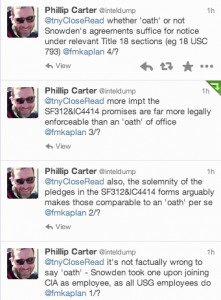The Torture Apologists Raise Brennan’s Torture-Derived Scary Memos
Some time in mid-2004, 8 high ranking National Security officials gave then presiding FISA Court Judge Colleen Kollar-Kotelly a briefing. Their goal was to convince her the then halted and now-discontinued Internet dragnet program was so important, and the terrorist threat against the US so great, she should write a shoddy legal opinion authorizing NSA to restart the program under the authority of the FISA Pen Register statute.
As part of the briefing, they replicated a process they had used for Bush’s illegal wiretap program: to have CIA’s analytical people write what they called a “scary memo” explaining why al Qaeda was so dangerous we had to continue that dragnet.
After the terrorism analysts completed their portion of the memoranda, the DCI Chief of Staff added a paragraph at the end of the memoranda stating that the individuals and organizations involved in global terrorism (and discussed in the memoranda) possessed the capability and intention to’ undertake further terrorist attacks within the United States. The DCI Chief of Staff recalled that the paragraph was provided to him initially by a senior White House official. The paragraph included the DCI’s recommendation to the President that he authorize the NSA to conduct surveillance activities under the PSP. CIA Office of General Counsel (OGC) attorneys reviewed the draft threat assessment memoranda to determine whether they contained sufficient threat information and a compelling case for reauthorization of the PSP. [my emphasis]
As head of the Terrorist Threat Integration Center (and later as head of the nascent National Counterterrorism Center), John Brennan oversaw that “scary memo.”
Last year, John Brennan admitted that he used information derived from the torture program (he calls it the detention and interrogation program) for those “scary memos.”
Burr: I’m still not clear on whether you think the information from CIA interrogations saved lives. Have you ever made a representation to a court, including the FISA court, about the type and importance of information learned from detainees including detainees in the CIA detention and interrogation program?
Brennan: Ahm, first of all, in the first part of your question, as to you’re not sure whether I believe that there has been information … I don’t know myself.
Burr: I said I wasn’t clear whether I understood, whether whether I was clear.
Brennan: And I’m not clear at this time either because I read a report that calls into question a lot of the information that I was provided earlier on, my impressions. Um. There, when I was in the government as the head of the national counterterrorism center I know that I had signed out a number of um affirmations related to the uh continuation of certain programs uh based on the analysis and intelligence that was available to analysts. I don’t know exactly what it was at the time, but we can take a look at that.
Burr: But the committee can assume that you had faith if you made that claim to a court or including the FISA court, you had faith in the documents in the information that was supplied to you to make that declaration.
Brennan: Absolutely. At the time if I had made any such affirmation, i would have had faith that the information I was provided was an accurate representation. [my emphasis]
We can imagine the kind of things Brennan might have used in his “scary memos” and that briefing to Kollar-Kotelly, on which the entire FISC-authorized dragnet .
Hassan Ghul — whom CIA tortured even after he provided critical information about Osama bin Laden’s courier — was already in custody, and given uncertainty about when his torture started, may have provided such information.

